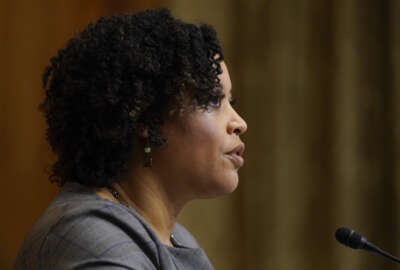Exclusive
Upcoming customer experience executive order underscores Biden’s equity goals
The Biden administration is working on an executive order focused on improving customer experience within government and building on its ongoing work to improve the...
Best listening experience is on Chrome, Firefox or Safari. Subscribe to Federal Drive’s daily audio interviews on Apple Podcasts or PodcastOne.
The Biden administration is working on an executive order focused on improving customer experience within government and building on its ongoing work to improve the equity of public-facing services.
A draft version of the executive order obtained by Federal News Network reflects plans that date back to at least this summer. A final version of the executive order remains the topic of ongoing conversations.
Four individuals, who requested anonymity to discuss their role in those discussions, confirmed seeing early drafts of the executive order in recent months. The Office of Management and Budget declined to comment.
While the administration is likely to update some text for the final version, the executive order’s draft language under consideration stresses as a central tenet that agencies set measurable goals to improve their customer experience, and that they use data to understand gaps in performance.
A former federal official said the executive order, in its current form, would “raise the visibility within the administration on reporting service levels,” and would fit together with the goals of an earlier executive order focused on advancing racial equity in underserved communities through government services.
The draft executive order directs agencies to link customer experience metrics to their strategic plans and priority goals. It also ties that progress into performance review requirements for members of the Senior Executive Service and senior management.
The former official said the upcoming executive order builds on the themes of the 21st Century Integrated Digital Experience Act (IDEA) and the recently updated OMB Circular A-11 and “takes it to the next level.”
The 21st Century IDEA, passed by Congress in 2018, sets targets for agencies to modernize their websites, digitize paper forms and accelerate the use of electronic signatures.
The draft executive order repeatedly tasks agencies with digitizing forms, as well as improving their websites and expanding the services they offer online.
The EO also focuses on agencies delivering services “equitably and effectively,” and with a focus on meeting the needs of underserved communities.
This version of the document directs agencies to advance equality for communities that face barriers to access and engage in efforts with other agencies “to reduce the friction of sharing data.”
Acting OMB Director Shalanda Young, in a blog post this summer, said the federal government, as the country’s largest employer and buyer of goods, need to better understand its blindspots when providing everything from medical research, to public housing, to disaster assistance.
As agencies improve their digital services and reduce barriers to obtaining government services, the draft executive order set goals of ensuring “those with disabilities and limited English are treated equally.”
While the executive order aims to further some of the goals outlined in 21st Century IDEA, the former official said the upcoming EO sees the need to improve customer experience not entirely as a technology issue, but as “breaking down siloes” and creating cross-agency CX teams.
However, the former official said the additional money for the Technology Modernization Fund, as outlined in the Build Back Better framework, will likely help agencies meet the executive order’s goals.
The House Rules Committee earlier this month adopted an amendment to the spending framework that would give $250 million to the TMF, as well as $200 million to the General Services Administration’s Federal Citizen Services Fund and $50 million to OMB’s Information Technology Oversight and Reform (ITOR) fund.
The draft executive order also supports requirements the administration already laid out for agencies in its updated A-11 Circular from September.
OMB, through that memo, already linked equity principles to customer experience goals, and made CX metrics a part of performance standards for agency executives.
Agencies have until January 2022, under the updated A-11 memo, to submit plans to improve the equity of the services they provide to the public. Those deliverables are particularly crucial for a growing list of High-Impact Service Providers (HISPs).
OMB in September added the Census Bureau and the Agriculture Department’s Food and Nutrition Service and Rural Development, as well as several other Treasury Department subcomponents to its list of 33 HISP agencies.
The draft executive order tasks OMB with issuing guidance for HISPs to manage their customer experience, assess their performance, and “include meaningful measures and the perspective of the public.”
The executive order tells agencies to make the “voice of the customer” a driving force behind all customer experience decisions, and to model online tools through human-centered design, as well as user research and testing.
The draft executive order outlines customer experience goals unique to specific agencies, but also highlights several “joint action” projects for multiple agencies to work on together.
Individual agency actions under consideration include the State Department providing a new online passport renewal experience, the Social Security Administration creating a mobile-accessible online platform that can handle all transactions and the Transportation Security Administration implementing new tools at airport security checkpoints to reduce passenger wait times.
The draft executive order also calls for cross-agency collaboration to tackle “customer life experiences,” or critical moments that require interaction with multiple government entities.
Possible projects include a partnership between the Office of Personnel Management and the Defense, Treasury and Education departments to streamline public service loan forgiveness for veterans and government employees.
The draft executive order also considers the possibility of the U.S. Digital Service and the Postal Service teaming up to allow Americans “to change their address only once and have it update everywhere.”
It also proposes the General Services Administration help implement Login.gov at the Department of Veterans Affairs.
In one of its more aspirational goals, the draft EO directs agencies to work together to ensure that individuals are notified of benefits they qualify for automatically, and that federal services should be more accessible to state and local governments.
The draft executive order would elevate USA.gov to serve as a “federal front door” for most, if not all government services. It also sets the U.S. Web Design System (USWDS) as the design standard for government websites.
Recreation.gov stands out as one interagency website built to uphold these customer experience principles. It gives customers a one-stop-shop to reserve campsites, schedule tours or obtain permits to cut down Christmas trees in national forests.
The site pulls together resources from a dozen agencies, including the Bureau of Land Management, the National Park Service, the Fish and Wildlife Service and the Forest Service.
The Biden administration, meanwhile, is already backing some customer experience investments.
GSA’s Technology Transformation Services (TTS) on Monday announced 14 agency projects received $150 million in American Rescue Plan Act funding in fiscal 2021 to reimagine public-facing digital services that have helped the U.S. recover from the COVID-19 pandemic.
Projects that received funding include TTS helping the Agriculture Department’s Farm Service Agency automate debt relief processes for farmers and improving Search.gov to help users navigate thousands of federal websites.
GSA Administrator Robin Carnahan, in a statement, said the projects demonstrate how “government can move at the speed of need and deliver for the people and communities we serve.”
Carnahan added that continued funding for the TMF ensures agencies “have an opportunity to make a truly transformative impact and reimagine how we deliver services to the public.”
Copyright © 2025 Federal News Network. All rights reserved. This website is not intended for users located within the European Economic Area.
Jory Heckman is a reporter at Federal News Network covering U.S. Postal Service, IRS, big data and technology issues.
Follow @jheckmanWFED






